By Robert Moynihan
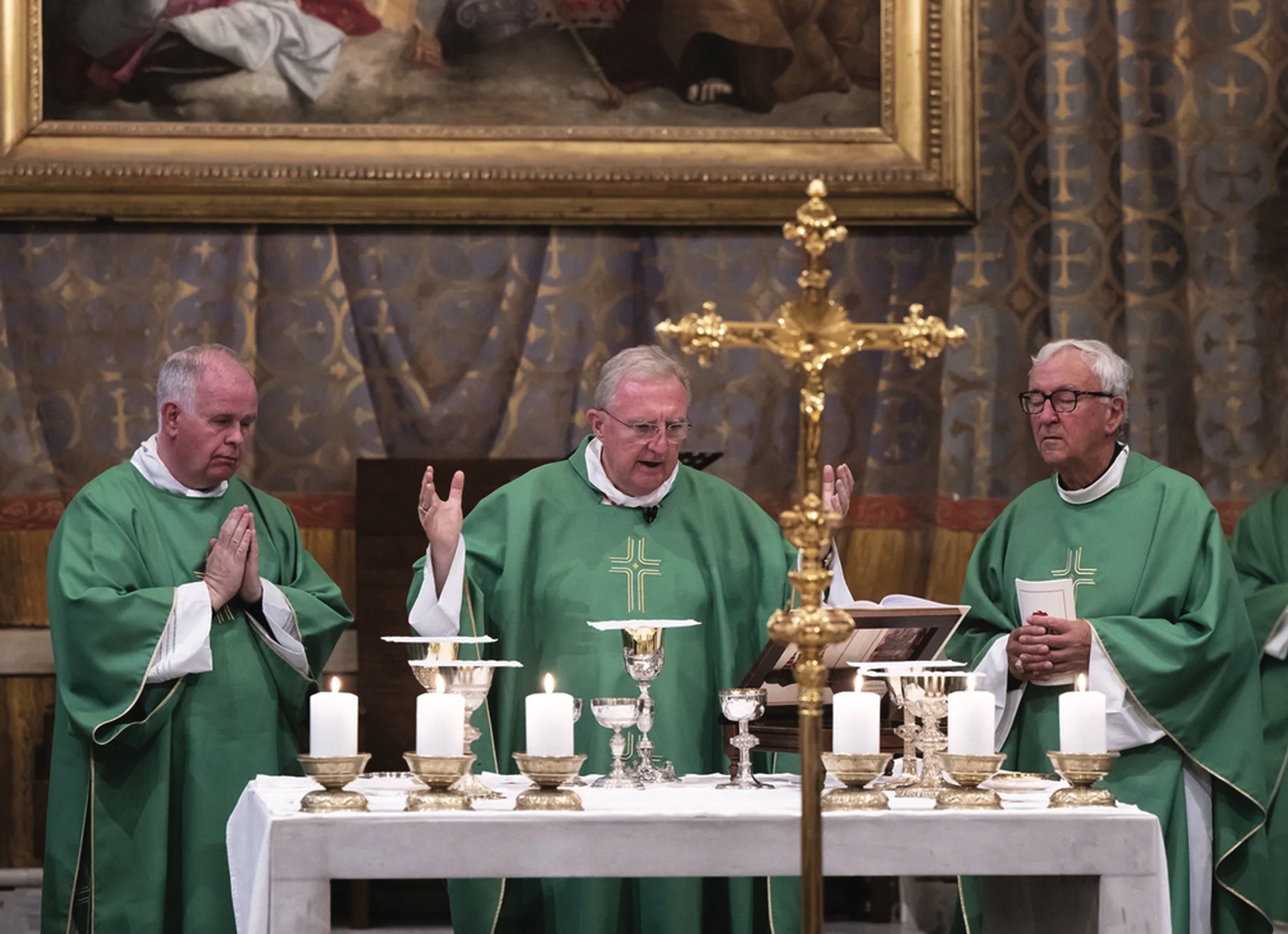
British Cardinal Arthur Roche, 73, the Pope’s head of the Dicastery for Divine Worship since 2021, spoke briefly in a BBC report on Sunday, March 19 on the issue of the Vatican’s limiting of the Traditional Latin Mass (abbreviated as the “TLM”) on July 16, 2021, in Traditionis custodes. The BBC report also included the opinions of several British Catholics who attend and appreciate the old rite of the Mass.
Roche’s abbreviated remarks featured most prominently his claim that, in regard to the liturgy, in regard to what happens at Mass, “the theology of the Church has changed.” This was striking, and is material for reflection.
Roche explained his viewpoint this way: “You know, the theology of the Church has changed. Whereas before, the priest represented, at a distance, all the people — they were channeled, as it were, through this person who alone was celebrating the Mass. It is not only the priest who celebrates the liturgy, but also those who are baptized with him. And that is an enormous statement to make.”
He is right: it is an “enormous statement to make.”
Enormous, because it seems to say what very few up to now have been willing to say explicitly: that there has not been “continuity” in Catholic teaching on this matter from prior to the Council, through the Council, and after the Council, up until today, but a kind of “rupture,” a “change” in teaching.
However, it seems that it was the chief burden of Pope Benedict XVI’s theological endeavor to express, define and defend the belief that what the Church believes about the liturgy, about the Mass, was not a rupture with the past, was not changed by the Council, but was in continuity, presenting traditional teaching at and after the Council in a way which enabled the inner, unchanging meaning, the perennial meaning, the meaning handed down “from the beginning,” from apostolic times, of the Church’s teaching on the Mass, and the priesthood, to be presented effectively in this period of history, our present time.
Not change, but continuity.
Because it would create a theological problem to say “the teaching has changed.”
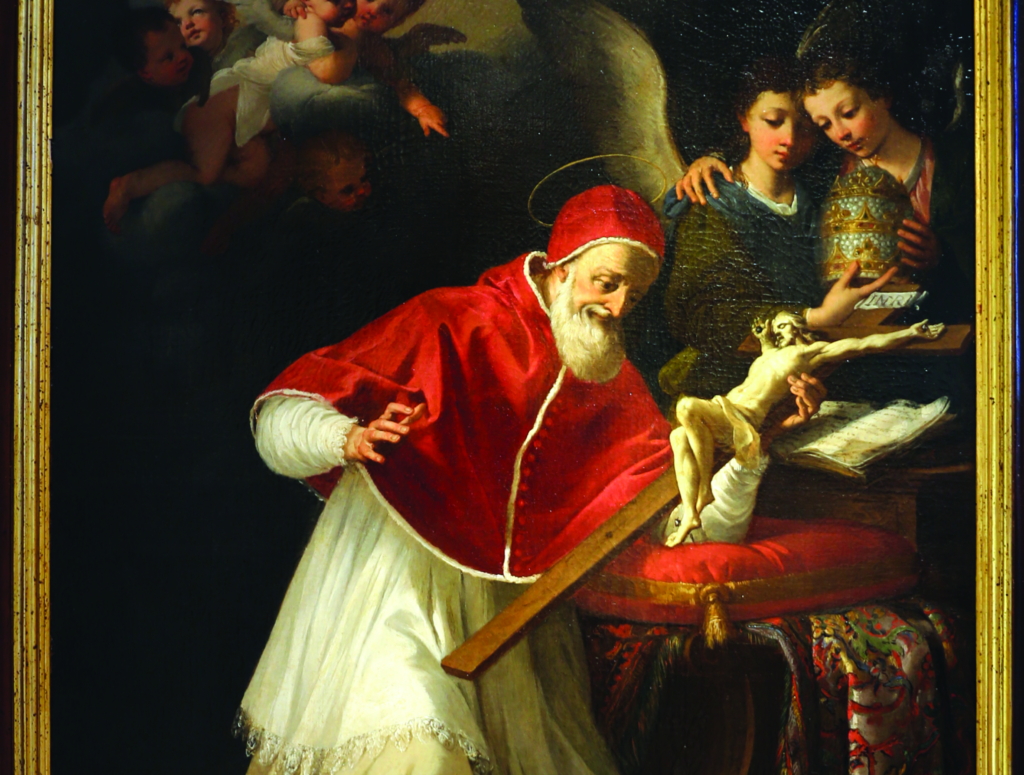
A painting of Pope Pius V, the Pope of reference for the Traditionalists, used in one of several billboards appearing in Rome (as seen below) in late March with the quote, from his 1570 apostolic constitution Quo Primum. Translated: (Heading on green background) For the love of the pope — For the peace and unity of the Church — For the freedom of the traditional Latin Mass; (Quoted text) “We decree and declare that the present Letters may at no time be revoked or diminished, but always set and valid; they must remain in force.”
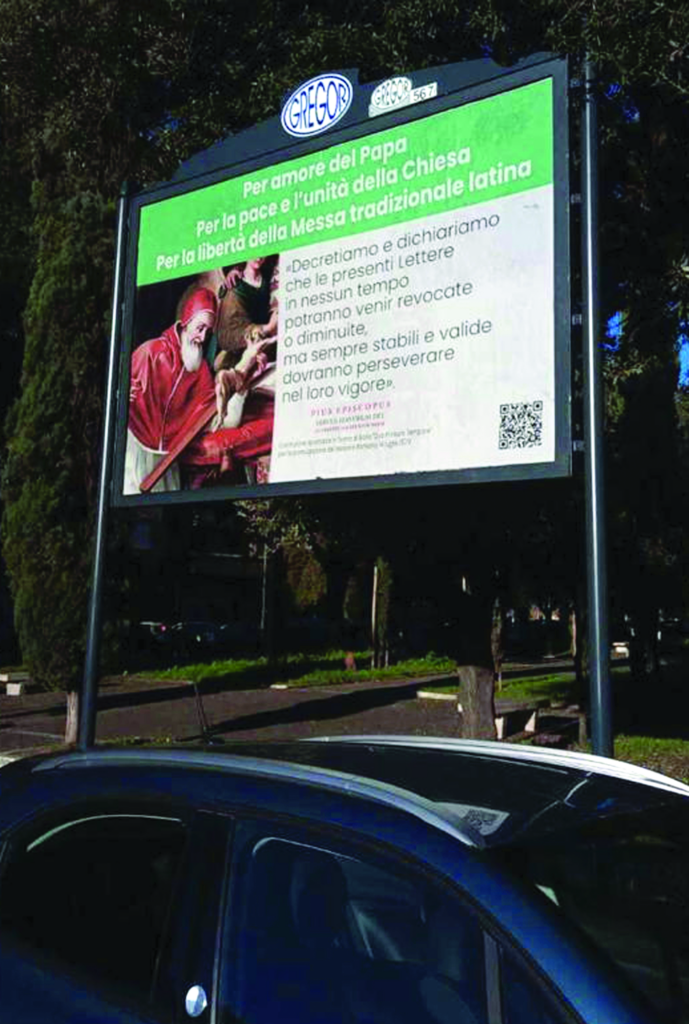
Contradicting Pope Benedict?
The striking thing about what Roche is saying is precisely this, that it seems to contradict the central teaching of Pope Benedict: that the new Mass is not simply a “more accessible” Mass for ordinary people in the pews (because, for example, the words are in the vernacular rather than an ancient language, Latin, that few people know) but that it actually represents a “change” in the theology of the Mass.
Is this actually what the assembled bishops at the Second Vatican Council said, or intended? Is there any place where the Council Fathers say, “We are going to have a new theology of the Mass” (evidently, holding that what the Church had taught up to that time on the matter was in some way deficient, or incomplete)? Is it not rather the case that Pope John XXIII and the Council Fathers said, “We would like to keep the same theology of the Mass as always, but allow the ordinary faithful to understand it better”?
And is it not the case that some of the changes made — in order to make the Mass “more accessible” — like (for example) the shift of the position of the priest, from facing the altar to facing the people, had the opposite effect from the one intended?
That is, in the old Mass, do not the people sense clearly that they indeed, along with the priest and, as it were, led by him, are, yes, participating in the offering of the Holy Sacrifice?
And is it not, rather, in the Novus Ordo, with the priest facing the people, that the assembled laity feel as if they are a passive audience at the rather unpredictable “show” that the priest presents, not according to time-honored rubrics handed down for centuries, but according to the events of the day and the whims of the particular priest?
In any case, is it not the case that Catholic theology holds that the priest is ordained to offer the very bodily sacrifice of Christ Himself, in a way that the people may participate in, but cannot accomplish without the presence of the ordained priest?
To suggest that the primary action of the ordained priest is not different from that participatory action of the people at Mass would seem not in keeping with traditional Catholic teaching on this matter; that is, it would seem to represent a change in theology… risking being a development not in keeping with perennial Catholic teaching.
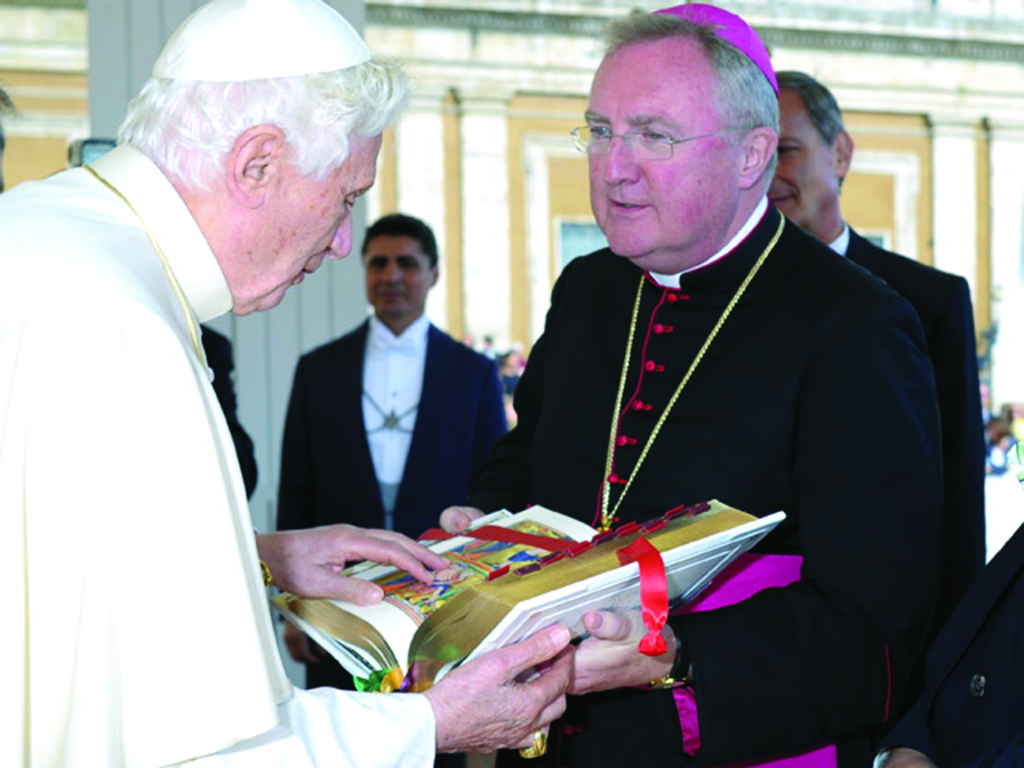
British Cardinal Arthur Roche with the late Pope Benedict
An “Unexpected Battleground”
You can listen to the BBC report in which Cardinal Roche, and others, are interviewed here: https://bbc.in/3K2z6DP
You must skip the first 5 minutes, and start precisely at 5:12 into the program, to hear the newsman ask Cardinal Roche about the Latin Mass, which the newsman says, quite dramatically, has become “an unexpected battleground in a Catholic culture war over the future direction of the Church.”
At 5:47, someone (evidently a priest) sings a few words from the old Latin liturgy, “vere dignum et iustum est, aequum et salutare…” (“truly worthy and just it is, fitting and helpful for salvation”) and then the correspondent says that, while Pope Benedict provided space for the traditional Latin Mass, Pope Francis has “changed the rules” and required bishops to seek permission from Rome before any celebration of the old Latin Mass. A Catholic speaks of the beauty of the silences in the old Mass.
The correspondent then explains how many vibrant traditional communities are being repressed. And a priest from England who favors the celebration of the old Mass asks Pope Francis and Cardinal Roche to reverse their restrictions on the old Mass.
Catholic journalist Austen Ivereigh then defends the decision of Pope Francis; he asserts that the Traditional Mass serves as a rallying point for a “movement” of Catholics who oppose Vatican Council II.
Precisely at the 10:19 mark in this report, the correspondent introduces Cardinal Arthur Roche. In his 24 seconds of speaking, the cardinal speaks the words also quoted above: “You know, the theology of the Church has changed. Whereas before, the priest represented, at a distance, all the people — they were channeled, as it were, through this person who alone was celebrating the Mass. It is not only the priest who celebrates the liturgy, but also those who are baptized with him. And that is an enormous statement to make.”
That is the extent of his remarks. The report ends after another Catholic layman speaks.
As Lifesitenews reported, Liturgical scholar Matthew Hazell highlighted Roche’s comments, noting that contrary to the cardinal’s claim, the teaching of the Church has not changed.
He pointed to the teaching of Pope Pius XII in his 1947 encyclical Mediator Dei, in which the pontiff outlined the Catholic teaching on the congregation uniting themselves to the priest in the sacrifice of the Mass.
“Now it is clear that the faithful offer the sacrifice by the hands of the priest from the fact that the minister at the altar, in offering a sacrifice in the name of all His members, represents Christ, the Head of the Mystical Body. Hence the whole Church can rightly be said to offer up the victim through Christ…
“The fact, however, that the faithful participate in the Eucharistic sacrifice does not mean that they also are endowed with priestly power.
“It is very necessary that you make this quite clear to your flocks…
“Now the faithful participate in the oblation, understood in this limited sense, after their own fashion and in a twofold manner, namely, because they not only offer the sacrifice by the hands of the priest, but also, to a certain extent, in union with him.
“It is by reason of this participation that the offering made by the people is also included in liturgical worship…” (Pius XII, Mediator Dei, 1947)
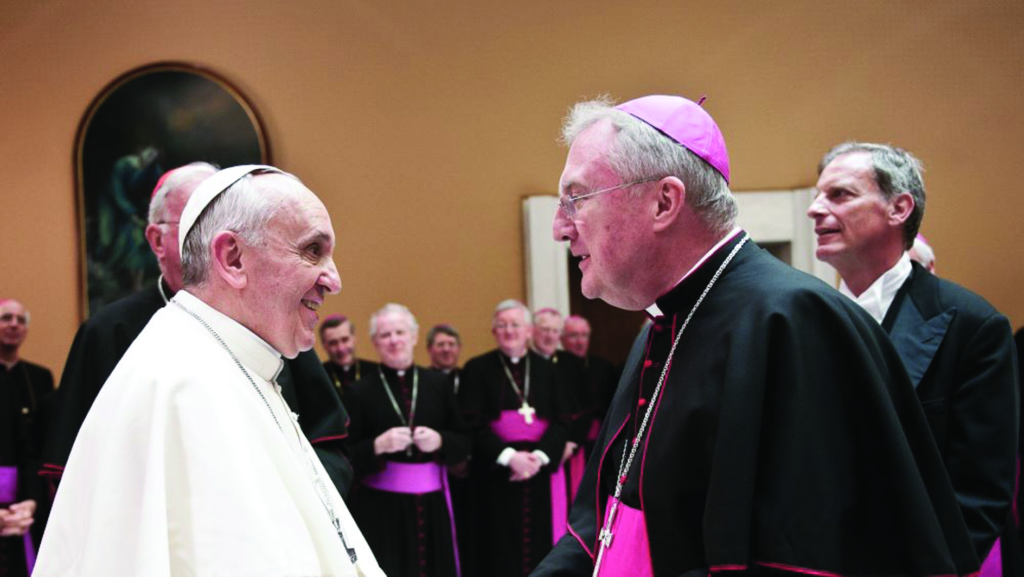
Cardinal Roche with Pope Francis
The Emperor Has No Clothes
American Catholic scholar Dr. Peter Kwasniewski, author of The Once and Future Roman Rite and other books on the Traditional Mass, commented on Cardinal Roche’s BBC interview for Inside the Vatican. His reaction: “Cardinal Roche is wrong about the theology of the Mass prior to the Council, as can be seen in an unbroken line of magisterial documents and popular commentaries and devotionals on the Mass, some of them intended for popular audiences, that speak of the laity’s offering of the Mass in union with (but also in distinction from) the priest’s offering of it.
“He is wrong too about the liturgy prior to the Council, because the Roman Rite, like every other approved and received rite, always speaks of the offering of the people (Orate, fratres… Pray, brethren, that your sacrifice and mine may be acceptable…); and there are plenty of other indications in the texts, faithfully printed in countless hand missals used by the faithful as much in the 1950s as in the 2020s).
“He is also wrong about Vatican II, which clearly affirms the ontological, i.e., essential, difference between the ordained priesthood, which empowers the priest to offer the Holy Sacrifice on behalf of the living and of the dead, and the common priesthood, which empowers the baptized to unite themselves, body and soul, to the Son’s perfect offering to His Father.
“So much of this is Catholicism — found in the littlest kids’ version of the Baltimore Catechism.
“It’s becoming a huge embarrassment that these prelates either know next to nothing about their subjects or are ready to throw truth under the bus for the sake of Francis’ obsession against ‘backwardism,’ at a time when there are thousands of Catholics well-educated about the liturgy constantly posting on social media.
“The emperor has no clothes, and the moral authority of the Vatican is plummeting like overpriced stocks in a bear market.”
Other Catholic commentators respond to Cardinal Roche’s remarks
Teaching that the laity participate in offering the Holy Sacrifice is nothing new
 By Michael Haynes, LifeSiteNews, March 20, 2023
By Michael Haynes, LifeSiteNews, March 20, 2023
While the arguments of the “priestly people” have been much proposed since Vatican II, chiefly by those looking to eradicate a difference between priests and laity, Pius XII noted clearly [in Mediator Dei, November 20, 1947, Par. 93] the difference in their respective actions: “But the conclusion that the people offer the sacrifice with the priest himself is not based on the fact that, being members of the Church no less than the priest himself, they perform a visible liturgical rite; for this is the privilege only of the minister who has been divinely appointed to this office: rather it is based on the fact that the people unite their hearts in praise, impetration, expiation and thanksgiving with prayers or intention of the priest, even of the High Priest himself, so that in the one and same offering of the victim and according to a visible sacerdotal rite, they may be presented to God the Father. It is obviously necessary that the external sacrificial rite should, of its very nature, signify the internal worship of the heart.”
Pius XII also drew from Pope Innocent III to denote the teaching of the Church in the joint offering of the sacrifice: “‘Not only,’ says Innocent III of immortal memory, ‘do the priests offer the sacrifice, but also all the faithful: for what the priest does personally by virtue of his ministry, the faithful do collectively by virtue of their intention.’”
Hence, Roche’s claim that the theology has changed does not seem to be supported by Church teaching — both that of recent times and that made by popes from ancient eras. His argument that the people now join the priest in offering the sacrifice has always been taught, with the careful differentiation between the priest and people’s various roles.
Vatican and “rad trads” agree on this: the new Mass expresses a “new religion”
 By Michael Brendan Dougherty, National Review, March 22, 2023
By Michael Brendan Dougherty, National Review, March 22, 2023
Just as important as Roche’s confirmation that the present Vatican has done away with wide permission for the old Mass is his affirmation of the underpinning assumptions that Benedict XVI used to license it — namely, Benedict’s “hermeneutic of continuity,” or the idea that the Second Vatican Council did not impose upon the faithful anything substantively new or different from the faith that the Church held before it. Therefore, the old Mass and the new Mass must express the very same faith.
That is not this Vatican’s position. Roche and the Vatican agree with progressives who view the old Mass as unsuited to a Church that has a new theology. And so they agree with radical traditionalists, and the Lefebvrites, that the purpose of the new Mass was to impose a new religion upon the Church.
Roche is “casting about” for a new rationale to suppress the Traditional Mass
By Dr. Joseph Shaw, OnePeterFive.com, March 24, 2023
I find myself, here, and not for the first time, defending the words of the Second Vatican Council against an interpretation which would impute to them theological novelties incompatible with the perennial teaching of the Church. It’s beyond the scope of this article to do the same thing for everything the Council said, but at least on this important issue, of the manner in which the faithful participate in the Mass, Austen Ivereigh should note that I am not the one criticizing Vatican II. It is Cardinal Roche, by implication, who seems to be casting it as introducing an historical rupture into the teaching of the Church.
He can’t, really, have meant this, but I do wonder what he did mean. It is clear that he is casting about for a different kind of rationale for the planned suppression of the Traditional Mass from the one offered by Pope Francis in the Letter to Bishops: one not just based on the empirical claim that its supporters are bad people, which fares so badly when a journalist takes the trouble to ask some worshippers about it. He would like an argument based on the theology of the liturgy, something that would allow him to say that it is objectively bad to allow any celebrations of the Traditional Mass to continue longer than absolutely necessary.
I’d love to hear more about this, because any such argument is going to have this difficulty: that if the Traditional Mass is bad, then the Church’s entire liturgy was bad for fifteen centuries, and most probably the Eastern Rites are bad even today. It would be intriguing indeed to discover that the Dicastery for Divine Worship is saying that celebration ad orientem is theologically problematic, while the Dicastery for the Eastern Churches is at the very same time trying to impose celebration ad orientem on the Syro-Malabars.
Roche in Letter to Germans
In seeming contradiction to his BBC remarks, Roche letter cites unique roles of priest
In a March 30 article by CNA-Germany’s A.C. Wimmer, Cardinal Arthus Roche was revealed to have written a seven-page letter to the head of the German Bishops’ Conference, Bishop Georg Bätzing of Limburg, warning him that the German Synodal Way’s proposal for lay people to regularly baptize and preach Mass homilies was not allowable.
He then went on to give doctrinal reasons supporting these disciplines. According to the CNA report, “On the issue of homilies, Roche wrote that the reason why lay people cannot regularly preach at Mass is not due to their need for ‘better theological preparation or better communication skills.’ Nor is the intent to create ‘inequalities among the baptized.’
“Instead, the cardinal pointed to ‘distinctions made by the Spirit, who produces different charisms that are distinct and complementary.’
“Roche wrote that well-formed lay people should contribute, for instance, as catechists or by conducting conversations about Sacred Scripture.
“However, he added that lay people could not give the homily at Mass since only someone ordained ‘sacramentally represents Christ by virtue of the sacra potestas [sacred power] conferred on him at ordination.’
“Explaining that the issue of preaching at Mass was, in other words, a sacramental rather than an educational matter, Roche warned of ‘misunderstandings’ about the figure and identity of the priest, who is the only one who can act ‘in persona Christi capitis’ [in the person of Christ, the head of the Church] by virtue of the sacrament.”
According to the report, Cardinal Roche also addressed the issue of lay people performing baptisms as a matter of routine, saying that, with the exceptions of danger of death or areas of persecution or mission territories, such a practice did not comport with canon law.
One of the more interesting things about Cardinal Roche’s letter to the German bishops is that in it, he almost seems to walk back some of his earlier remarks to the BBC about the role of the congregation versus the role of the priest in offering the Mass.
In the BBC interview, he had said: “You know, the theology of the Church has changed. Whereas before, the priest represented, at a distance, all the people — they were channeled, as it were, through this person who alone was celebrating the Mass. It is not only the priest who celebrates the liturgy, but also those who are baptized with him. And that is an enormous statement to make.”
The baptized lay people, he said, “celebrate the liturgy” along with the priest; he made no further distinctions, and claims this understanding is a “change” in theology.
But in the letter to the German bishops, he appears to be saying the opposite: that the role of the priest, who alone offers the Mass in persona Christi, is absolutely unique due to his sacramental ordination, and that lay people are not able to participate in the Mass, and offer to the Father the Body and Blood of Christ, the way that the priest does – which is the traditional teaching of the Church.
Perhaps the Cardinal’s more recent clarification of the doctrine on the priest’s role in celebrating the liturgy of the Mass was in some measure a response to the criticisms following his BBC interview. Perhaps the Cardinal was forced, upon further reflection, to reconsider his enthusiasm for a Mass re-imagined as a more egalitarian celebration, in which there is little to no real distinction between priest and people.
Perhaps, in the interview, the Cardinal simply misspoke.
Perhaps, the Cardinal was, as Dr. Joseph Shaw remarked on March 24 in the online journal OnePeterFive, simply “casting about for a different kind of rationale for the planned suppression of the Traditional Mass from the one offered by Pope Francis in the Letter to Bishops: one not just based on the empirical claim that its supporters are bad people, which fares so badly when a journalist takes the trouble to ask some worshippers about it. He would like an argument based on the theology of the liturgy…”
Billboards Supporting Traditional Mass Spring Up around Rome in Late March
“Out of Love for the Pope”
March 28, 2023

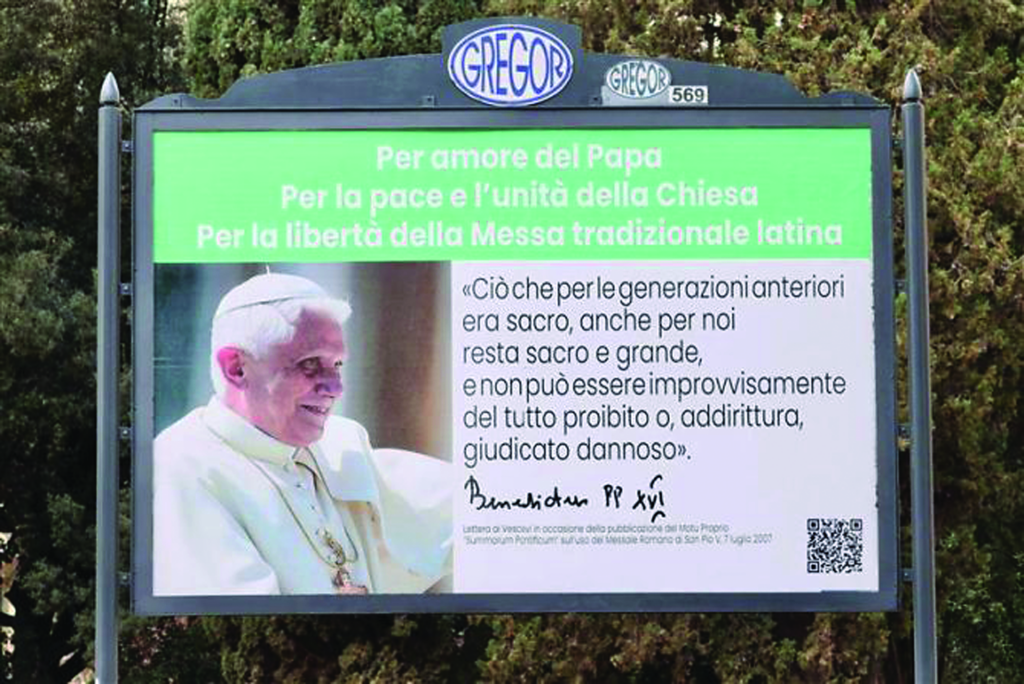
John Paul II and Benedict XVI are also depicted in the traditionalists’ campaign, with phrases of approval and support for the ancient Latin liturgy
Starting this morning, and lasting for 15 days, several dozen billboards dedicated to the traditional liturgy will be posted near and around the Vatican. An organizing committee, whose members are participating in a personal capacity and who come from different Catholic entities (such as the blogs, Messainlatino and Campari & de Maistre, and the associations, National Committee on Summorum Pontificum and the St Michael the Archangel Association), wished to make public their profound attachment to the traditional Mass at a time when its extinction seems to be planned.
They do so out of love for the Pope, so that he might be paternally opened to understanding those liturgical peripheries that no longer feel welcome in the Church, because they find in the traditional liturgy the full and complete expression of the entire Catholic Faith.
“What earlier generations held as sacred, remains sacred and great for us too, and it cannot be all of a sudden entirely forbidden or even considered harmful” (Benedict XVI, Letter to the Bishops on the occasion of the publication of the Apostolic Letter Summorum Pontificum).
The growing hostility towards the traditional liturgy finds no justification on either a theological or pastoral level.
The communities that celebrate the liturgy according to the 1962 Roman Missal are not rebels against the Church.
On the contrary, blessed by steady growth in lay faithful and priestly vocations, they constitute an example of steadfast perseverance in Catholic faith and unity, in a world increasingly insensitive to the Gospel, and an ecclesial context increasingly yielding to disintegrating impulses.
For this reason, the attitude of rejection with which their own pastors are forced to treat these communities today is not only reason for bitter sorrow, which these faithful strive to offer for the purification of the Church, but also constitutes a grave injustice. In the face of this injustice, charity itself demands that we not remain silent: for “indiscreet silence leaves in error those who might have been instructed” (Pope St Gregory the Great, Pastoral Rule, Book II, Chapter 4).
In the Church of our day, in which listening, welcoming, and inclusion inspire all pastoral action, and there is a desire to build ecclesial communion “with a synodal method,” this group of ordinary faithful, young families, and fervent priests has the confident hope that its voice will not be stifled but welcomed, listened to, and taken into due consideration.
Those who go to the “Latin Mass” are not second-class believers, nor are they deviants to be re-educated or a burden to be gotten rid of
—Press Release, The Organizing Committee
(Toni Brandi, Luigi Casalini, Federico Catani, Guillaume Luyt, Simone Ortolani, Marco Sgroi)
[email protected]
(Trans. Diane Montagna)
Francis fears “rejection of the Church and its institutions” in TLM adherents
Excerpt from Traditionis Custodes, Pope Francis’ letter to bishops
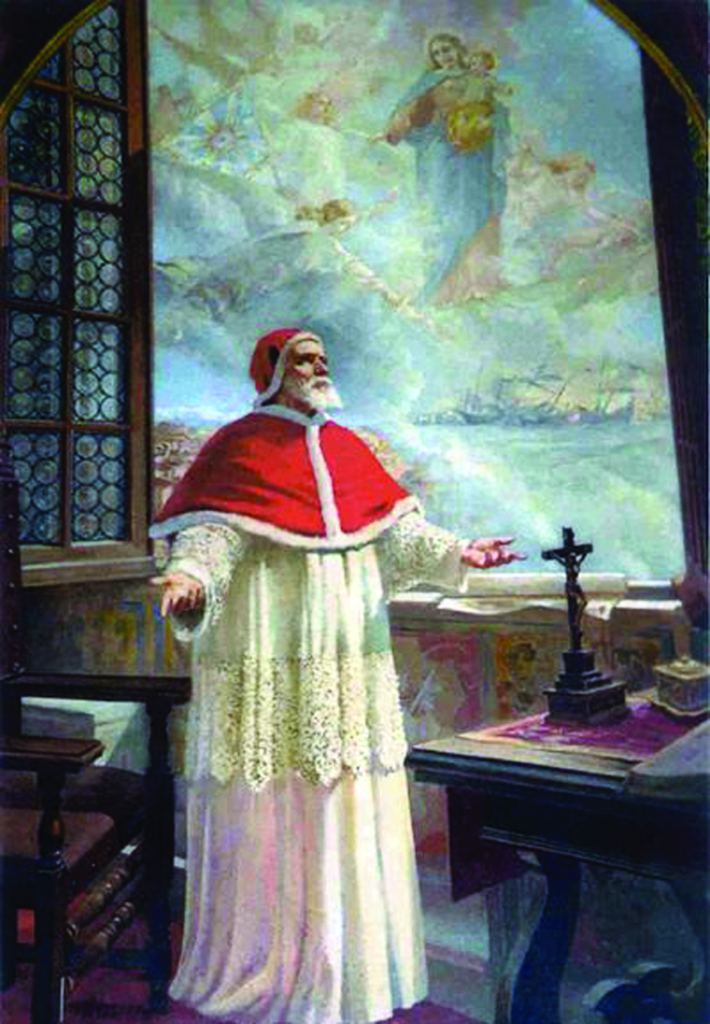
Pius V thanks the Virgin for the victory of the Christian fleet against the Turks in the Battle of Lepanto October 7, 1571
Pope Francis, in his July 16, 2021 letter to bishops accompanying the motu proprio Traditionis Custodes, limiting the celebration of the Traditional Latin Mass after it had been liberalized by Popes John Paul II and Benedict, explained his rationale for the move:
“Unfortunately, the pastoral intent of my predecessors… has been used to increase distances, harden differences, and build oppositions that hurt the Church and hold back its progress, exposing it to the risk of divisions.
“I am equally saddened by the abuses on both sides in the celebration of the liturgy. Like Benedict XVI , I too regret that ‘in many places people do not celebrate faithfully the prescriptions of the new Missal, but that it is misunderstood as an authorization or even as an obligation to creativity, which often leads to deformations bordering on the unbearable.’ But nonetheless, I am saddened by an instrumental use of the 1962 Missale Romanum, increasingly characterized by a growing rejection not only of the liturgical reform, but of the Second Vatican Council, with the groundless and untenable claim that it betrayed tradition and the ‘true Church.’
“One last reason I want to add as the foundation of my choice: the close relationship between the choice of celebrations according to the liturgical books prior to the Second Vatican Council and the rejection of the Church and its institutions in the name of what they judge to be the ‘true Church.’ It is a behavior that contradicts communion, fueling that drive for division.”






Facebook Comments